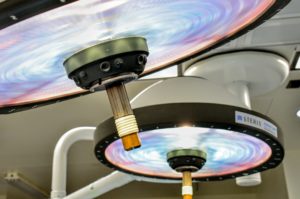In section 21 CFR 820.3 of the federal code, FDA defines design verification as “the process of confirmation by examination and provision of objective evidence that specified requirements have been fulfilled.” Design validation is defined as “the process of establishing by objective evidence that product specifications conform with user needs and intended use(s).”
Medical product design verification and validation activities (called “Phase 3” and “Phase 4” at GCMI) typically come after a design phase (called “Phase 2” at GCMI). At the completion of the design phase, a product will have well-defined design inputs, plus fully described design features and manufacturing methods. Design verification and validation then takes this design output (product) and ensures that it meets all engineering requirements and user needs, respectively.
Design validation ensures that you have made the “right” product – according to the customer’s needs. Design verification ensures that the team has made the product “right” – according to regulatory and engineering requirements.
How does verification and validation in the design and development process “translate” to preclinical? GCMI / T3 Labs Preclinical Program Director Evan Goldberg tells us in this Q&A.
Let’s start with an overview, how much design verification and validation work is preclinical?
“The goal, including scope and objectives, of the vast majority of preclinical work is to verify and validate new medical devices and technologies as well as drugs and biologics. For all Class III, and many Class II devices, significant preclinical work is required to demonstrate the product or technology’s safety and efficacy. These preclinical studies typically compliment a host of bench verification and validation tests that demonstrate the performance and safety of the product. Bench tests may evaluate requirements such as mechanical stability, electrical safety, chemical composition, sterility and usability.”
At what point does preclinical work for design verification and validation need to be done in a rigorous GLP “environment?”
“Provided that the FDA is requiring in vivo data to demonstrate safety, or otherwise requiring GLP testing, a new medical device or technology is ready for GLP preclinical work when it has achieved or entered ‘design freeze.’”
How and where does preclinical work fit into medtech design verification and validation’s goals?
“This depends on the device and pathway, user needs and engineering requirements. In some cases, the entirety of verification may be completed on the bench top. However, if you have a resorbable material, for example, and it is intended to be 100% resorbed in six months, you will most likely need to conduct an animal study to prove it’s fully resorbed. We would consider this critical to verifying that product performs as intended according to its engineering requirements.
“Preclinical work for validation addresses usability and performance in a hands-on clinical environment. This is frequently done with surgeons in a cadaver or animal to validate performance as intended. The extent to which preclinical studies are required for validation depends on the device or technology, its classification and all associated regulatory requirements.”
Where does preclinical work ‘enter’ or contribute to verification activities?
“This varies widely based on the device or technology, its classification and any predicates. It could be at any point or at multiple points dependent upon defined engineering requirements and user needs.
“Preclinical work would enter verification activities very early in that stage for a resorbable material, implant or FDA Class III device given the need to see how the device or technology performs in a chronic survival animal for a period of time to verify and validate engineering requirements and that the product meets clinical needs.
“Preclinical work would enter verification activities later in the process for non-implantable products or technologies like surgical instruments that can be verified and validated in large part on the bench. Preclinical work later in the process assesses performance and human factors that can only be validated in a preclinical model, either cadaveric or in vivo.”
How much validation work involves preclinical?
“For a Class III device, preclinical work is a massive contributor to validation. For Class II devices the volume of preclinical work for validation varies. For example, an implantable titanium plate for fracture healing does not typically require any in vivo preclinical studies because it is a known material that has already been proven safe in humans. However, the same plate – or a titanium plate with a new coating – made with a new material never tested for biocompatibility, toxicity, safety and efficacy would likely demand a battery of preclinical testing per regulatory requirements.”
Where does preclinical work ‘enter’ or ‘participate in’ validation? 
“For validation, preclinical work is more common or more commonly required for safety and efficacy trials. This is especially true in GLP preclinical studies once Class III or certain Class II products or technologies have reached design freeze status to demonstrate their safety and ability to successfully perform its intended use.”
What does failure to complete related preclinical activities mean?
“Regulatory questions and a longer, more expensive pathway to commercialization. The worst case scenario is a promising device or technology meets its end by running out of funding when it didn’t have to if the proper, rigorous testing process had been adopted earlier.
“If you don’t sequence activities and expenditures appropriately at each stage from the bench top through preclinical testing and jump to design freeze using GLP preclinical testing as means to validate a product for 510k clearance, you’re not setting yourself up for success. This could result in repeating costly preclinical studies from GLP all the way back to the bench top – redesigning it to prove concept and feasibility. The number of ‘$10,000 days’ required for these activities has high potential to doom promising medical technologies.”
Successfully completing preclinical activities means…
“Clean data sets, stronger regulatory submissions, limited questions from regulatory bodies, faster clearance or approval, shorter time to market and shorter time to revenue.”
What other preclinical-related considerations should be considered prior to design verification and validation testing?
“Budgeting including common and commonly hidden costs in preclinical testing for verification and validation requirements. What type of testing can you do before cadaveric or in vivo testing to define as much as possible before the activities start getting very expensive? What bench top models can you use to answer questions required?
“You should also carefully vet any preclinical CRO you are considering using for medtech design verification and validation testing. Are they AAALAC accredited? Is their staff highly qualified inclusive of biomedical engineers and licensed veterinarians? Do they have the equipment and facilities onsite or readily available your work will need? What about access to external assets like pathologists or surgeons? What do their customers say or think about them?”
What happens at the end of DV&V?
At the end of successful medtech design verification and validation, a medical product is ready for regulatory submission or marketing, depending on the product’s regulatory classification. The manufacturing transfer phase typically follows, ensuring that high quality products can be made at sufficient product volumes.
What happens at the end of DV&V preclinical activities?
“Typically preclinical final report writing and regulatory submission finalization.”
Let’s talk
If you would like to take a deeper dive into our medical device design and development process including design verification and validation activities, please use the contact form below. We will put you in touch with the member of the team most appropriate to address your needs.
